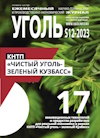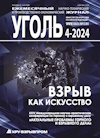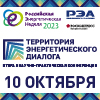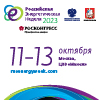
SAFETY
Original Paper
UDC 622.82 © Z.S. Gelmanova, L.V. Gorshkova, L.D. Rudnik, A.V. Mezentseva, 2022
ISSN 0041-5790 (Print) • ISSN 2412-8333 (Online) • Ugol’ – Russian Coal Journal, 2022, № 4, pp. 53-57
DOI: http://dx.doi.org/10.18796/0041-5790-2022-4-53-57
Title
EFFICIENCY OF USING EXPANDING SILTING PULP FOR ISOLATING FIRES IN MINES OF THE REPUBLIC OF KAZAKHSTAN
Authors
Gelmanova Z.S.1, Gorshkova L.V.2, Rudnik L.D.1, Mezentseva, A.V.1
1Karaganda Industrial University, Temirtau, 101400, Republic of Kazakhstan
2Toraigyrov University, Pavlodar, 140008, Republic of Kazakhstan
Authors Information
Gelmanova Z.S., Phd (Economic), Professor of the Department of Construction, Economics and Business, e-mail: zoyakgiu@mail.ru
Gorshkova L.V., Phd (Engineering), Professor of the department "PGTS"
Rudnik L.D., Senior Lecturer, Department of Construction
Mezentseva, A.V., Senior Lecturer of the Department of Construction
Abstract
The article identifies factors affecting the efficiency of insulating structures in mines. To prevent shrinkage of the pulp, it is proposed to add quicklime to its traditional composition, consisting of clay, sand and water. It was found that the presence of about 5-7% quicklime in the pulp prevents its shrinkage, and the presence of 20-25% quicklime in the pulp allows the pulp to swell by about 20% by volume. Experimental studies have been carried out to identify the aerodynamic resistance of porous layers of materials. The air permeability of the pulp and the effect of quicklime on the expansion of the pulp mixture, the air permeability of various compositions of the silting pulp, including the compositions used for the construction of filter bridges, have been determined. It has been established that the least air permeability is possessed by the pulp, which has quicklime in its composition.
Keywords
Insulating structure, Air permeability, Double dam, Pulp composition, Tightness, Endogenous fire.
References
1. Balovtsev S.V. Assessment of ventilation circuits with regard to geological and geotechnical conditions of coal seam mining. Mining Informational and Analytical Bulletin, 2019, (6), pp. 173-183. (In Russ).
2. Trinh L.H. & Nguyen V.N. Mapping coal fires using Normalized Difference Coal Fire Index (NDCFI): case study at Khanh Hoa coal mine, Vietnam. Mining Science and Technology (Russia), 2021, (6), pp. 233–240. Available at: https://doi.org/10.17073/2500-0632-2021-4-233-240(accessed 15.03.2022).
3. Filin A.E., Zinovieva O.M., Kolesnikova L.A. & Merkulova A.M. Prospects of safety control in combination of mining and metallurgy industries. Eurasian Mining, 2018, (1), pp. 31-34.
4. Nguyen Q.L., Nguyen Q.M, Tran D.T. & Bui X.N. Prediction of ground subsidence due to underground mining through time using multilayer feed-forward artificial neural networks and back-propagation algorithm – case study at Mong Duong underground coal mine (Vietnam). Mining Science and Technology (Russia), 2021, (6), pp. 241–251. Available at: https://doi.org/10.17073/2500-0632-2021-4-241-251(accessed 15.03.2022).
5. Hasanova N.Yu., Salyamova K.D. & Melikulov A.D.Analysis of the variability of the deformation properties of the rock mass and the possibility of managing them in various geotechnological processes. Voprosy nauki i obrazovaniya.2018, (10), pp. 35-39. (In Russ).
6. Ganova S.D., Skopintseva O.V. & Isaev O.N. On the issue of studying the composition of hydrocarbon gases of coals and dust to predict their potential hazard. Bulletin of the Tomsk Polytechnic University, Geo Assets Engineering, 2019, Vol. 330, (6), pp. 109-115. (In Russ).
7. Coal Degas Group, Murray American Energy Inc., Morgantown, West Virginia, USA Available online 11 July 2014. Chapter 8 – Coal Seam Degasification, pp. 155-175. Available at: https://doi.org/10.1016/B978-0-12-800880-5.00008-5 (accessed 15.03.2022).
8. Rilnikova M.V., Olizarenko V.V. & Mikhalchuk A.P.Formation and construction of bulkheads in openings of underground mines under the career filled with tailings. Mining Informational and Analytical Bulletin, 2014, (S1–1), pp. 124-137. (In Russ).
9. Kulikova A.A. & Kovaleva A.M. Use of tailings of enrichment for laying of the developed space of mines. Mining Informational and Analytical Bulletin, 2021, (2–1), pp. 144-154. (In Russ).
10. Reshetnyak S.N. & Maksimenko Yu.M. Analysis of the materials of hardening of damaged areas of the coal-bearing massif in the course of excavation work. Mining Informational and Analytical Bulletin, 2018, (11), pp. 39-45. (In Russ).
11. Hashemi S.S., Melkoumian N. & Taheri A. A borehole stability study by newly designed laboratory tests on thick-walled hollow cylinders. Journal of Rock Mechanics and Geotechnical Engineering, 2015, (7), pp. 519-531.
12. Ovchinnikov V.V. Thermochemistry of Heteroatomic Compounds: Calculation of the heat of Combustion and the heat of Formation of some Bioorganic Molecules with Different Hydrophenanthrene Rows. Open Journal of Physical Chemistry, 2011, (1), pp. 1-5.
13. Kordos J. Tests of new method of monitoring endogenous fire hazard in hard coal mines. Journal of Sustainable Mining, 2019, (18), pp. 134-141.
For citation
Gelmanova Z.S., Gorshkova L.V., Rudnik L.D. & Mezentseva A.V. Efficiency of using expanding silting pulp for isolating fires in mines of the Republic of Kazakhstan. Ugol’, 2022, (4), pp. 53-57. (In Russ.). DOI: 10.18796/0041-5790-2022-4-53-57.
Paper info
Received January 13, 2022
Reviewed February 1, 2022
Accepted March 22, 2022









